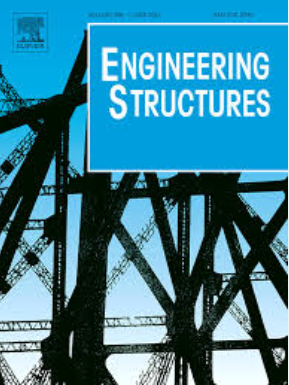采用SMA间隙阻尼器的基础隔震建筑的概率抗震性能评估
IF 6.4
1区 工程技术
Q1 ENGINEERING, CIVIL
引用次数: 0
摘要
护城河墙(MW)冲击容易发生在地震基础隔离的建筑物中,由于建筑的限制,这些建筑物的隔离间隙不足,特别是在强近场地震激励下。当发生MW冲击时,隔震层和上部结构的地震反应被显著放大。因此,各种滞后间隙阻尼器(GDs)已经被开发出来,在强震期间表现出额外的刚度和阻尼,以减轻冲击,同时在小到中等地震期间保持隔离系统的性能。然而,由于其有限的自中心(SC)能力,gps的有效性可能会在直接余震或未来地震中受到损害。因此,本研究在自适应隔震系统中开发了SC隔震系统,旨在通过将形状记忆合金(SMA)和钢结构相结合,实现多次强震时隔震层和上部结构的最优响应控制。设计了不同的隔震系统,即SMA-、钢-和组合-隔震系统,以实现在最大考虑地震下相同的最大承载变形,以进行比较研究。在考虑主余震序列的情况下,进行了地震易损性分析,研究了GDs的力学行为对隔震效果的影响。易损性分析结果表明,所设计的GDs与常规MWs相比,显著降低了轴承损坏的概率。阻尼器的力学行为对自适应隔离系统的隔离性能有显著影响。具体来说,与钢结构结构经历不可恢复的累积损伤不同,具有优异SC能力的SMA-GDs表现出更好的变形缓解,特别是在余震条件下,但由于其固有的较低的能量耗散能力,上层结构的漂移超出概率更高。组合gds显示了隔震层与上部结构之间的最优响应控制。本文章由计算机程序翻译,如有差异,请以英文原文为准。
Probabilistic seismic performance assessment of base-isolated buildings incorporating SMA gap dampers for pounding mitigation
Moat wall (MW) pounding is prone to occurring in seismically base-isolated buildings equipped with insufficient isolation clearances due to architectural constraints, particularly during strong near-field earthquake excitations. When MW pounding occurs, the earthquake responses of the isolation layer and superstructure are significantly amplified. Hence, various hysteretic gap dampers (GDs) have been developed to exhibit additional stiffness and damping for pounding mitigation during strong earthquakes, while maintaining the isolation system’s performance during small-to-moderate earthquakes. However, the effectiveness of GDs may be compromised during immediate aftershocks or future earthquakes because of their limited self-centering (SC) capabilities. For this reason, this study develops SC GDs in an adaptive isolation system, aiming to achieve optimal response control in the isolation layer and superstructure during multiple strong earthquakes through incorporating shape memory alloy (SMA) and steel GDs. Different isolation systems were designed with various GDs, i.e., SMA-, steel-, and combined-GDs, to achieve the same maximum bearing deformation under maximum considered earthquakes for comparative investigations. Seismic fragility analyses are conducted to investigate the influence of GDs’ mechanical behavior on isolation effectiveness, considering mainshock–aftershock sequences. Fragility analysis results show that the designed GDs significantly reduce the probability of bearing damage compared to conventional MWs. The mechanical behavior of GDs remarkably affects the isolation performance of the adaptive isolation systems. Specifically, unlike the steel-GDs experienced unrecoverable cumulative damage, the SMA-GDs with excellent SC capability exhibit superior deformation mitigation, especially under aftershock conditions, while sacrificing higher exceedance probabilities of superstructural drifts, which is due to the inherent lower energy dissipation capability. The combined-GDs demonstrate optimal response control between the isolation layer and the superstructure.
求助全文
通过发布文献求助,成功后即可免费获取论文全文。
去求助
来源期刊

Engineering Structures
工程技术-工程:土木
CiteScore
10.20
自引率
14.50%
发文量
1385
审稿时长
67 days
期刊介绍:
Engineering Structures provides a forum for a broad blend of scientific and technical papers to reflect the evolving needs of the structural engineering and structural mechanics communities. Particularly welcome are contributions dealing with applications of structural engineering and mechanics principles in all areas of technology. The journal aspires to a broad and integrated coverage of the effects of dynamic loadings and of the modelling techniques whereby the structural response to these loadings may be computed.
The scope of Engineering Structures encompasses, but is not restricted to, the following areas: infrastructure engineering; earthquake engineering; structure-fluid-soil interaction; wind engineering; fire engineering; blast engineering; structural reliability/stability; life assessment/integrity; structural health monitoring; multi-hazard engineering; structural dynamics; optimization; expert systems; experimental modelling; performance-based design; multiscale analysis; value engineering.
Topics of interest include: tall buildings; innovative structures; environmentally responsive structures; bridges; stadiums; commercial and public buildings; transmission towers; television and telecommunication masts; foldable structures; cooling towers; plates and shells; suspension structures; protective structures; smart structures; nuclear reactors; dams; pressure vessels; pipelines; tunnels.
Engineering Structures also publishes review articles, short communications and discussions, book reviews, and a diary on international events related to any aspect of structural engineering.
 求助内容:
求助内容: 应助结果提醒方式:
应助结果提醒方式:


